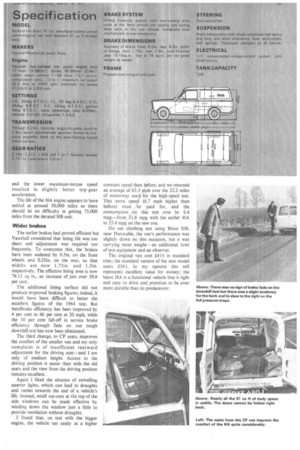CM ROAD TEST 3/7
Page 42

Page 43

If you've noticed an error in this article please click here to report it so we can fix it.
by Ron Cater AM I nst BE WHEN we tested the Bedford HA van in August 1964 we found it an efficient and comfortable little vehicle, and our opinion on that occasion has been borne out by the fact that the model has until recently remained almost unchanged. Now Vauxhall Motors Ltd, besides substituting the slightly larger HB Viva engine for the original one in this car-based van, have fitted wider brakes and specified the more comfortable CF van seats as standard.
When we tested the HA last month the changes proved worthwhile improvements on a still very competitive model. The original 1057 cc engine was tuned to suit its low-compression rating. The new engine has a capacity of 1159 cc but has been derated to provide a performance similar to the earlier unit; it is therefore less highly stressed and should have a longer life.
It produces 32.2 bhp net at 4600 rpmwhich is 8.1 bhp less than the smaller engine, but at 600 rpm fewer revs, a factor in extending engine life. Although the torque figure is slightly lower with the derated engine-51 lb ft compared with 55 lb ft-the peak is reached at 2000 rpm instead of 2600. The vehicle does not have to be pressed in order to achieve satisfactory average speeds.
The latest model proved almost identical in performance to the original version, though our four-stops-per-mile test showed slightly higher fuel consumption; acceleration was within 2sec of the previous results, and the lower maximum-torque speed resulted in slightly better top-gear acceleration.
The life of the HA engine appears to have settled at around 50,000 miles so there should be no difficulty in getting 75,000 miles from the derated HB unit.
Wider brakes The earlier brakes had proved efficient but Vauxhall considered that lining life was too short and adjustment was required too frequently. To overcome this, the brakes have been widened by 0.5in. on the front wheels and 0.25in. on the rear, so that widths are now 1.75in. and 1.5in. respectively. The effective lining area is now 79.15 sq in., an increase of just over 38.6 per cent The additional lining surface did not produce improved braking figures; indeed, it would have been difficult to better the excellent figures of the 1964 test. But handbrake efficiency has been improved by 4 per cent to 46 per cent at 20 mph, while the 10 per cent fall-off in service brake efficiency through fade on our tough downhill test has now been eliminated.
The third change, to CF seats, improves the comfort of the smaller van and my only complaint is of insufficient rearward adjustment for the driving seat—and I am only of medium height. Access to the driving position is easier than with the old seats and the view from the driving position remains excellent.
Again I liked the absence of swivelling quarter lights, which can lead to draughts and rattles towards the end of a vehicle's life. Instead, small cut-outs at the top of the side windows can be made effective by winding down the window just a little to provide ventilation without draughts.
I found that, on test with the bigger engine, the vehicle ran easily at a higher I constant speed than fore, and we returned an average of 63.3 ph over the 22.2 miles of motorway use for the high-speed test. This extra spec (6.7 mph higher than before) must /be paid for, and the consumption ,on this test rose by 6.4 mpg—from .41.8 mpg with the earlier HA to 25.4 mpg on the new one.
On our climbing test using Bison Hill, near Dunstable, the van's performance was slightly clown on this occasion, but it was carrying more weight—an additional lcwt of test equipment and an observer.
The original van cost £415 in standard trim; the standard version of the new model costs £561. In my opinion this still represents excellent value for money; the latest HA is a functional vehicle that is light and easy to drive and promises to be even more durable than its predecessor.




























































































